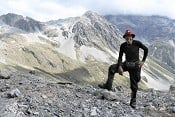In reply to Red Rover:
Pegs are still used on Scottish winter routes, but their use is frowned on by many and they shouldn't be used if there's an alternative
Buried axe belays work with curved axes. There have been studies published about the most effective configurations.
Body belays are used in winter because they make the belayer a stressed part of the system i.e. the force of a falling climber passes through the belayer before it hits the anchors and some is absorbed by the belayer. also it's easier to stop a fall gradually with a body belay, and reduce the forces on the anchors, which in winter, are often not as great as you'd like them to be [e.g. buried axes]
Post edited at 11:58









